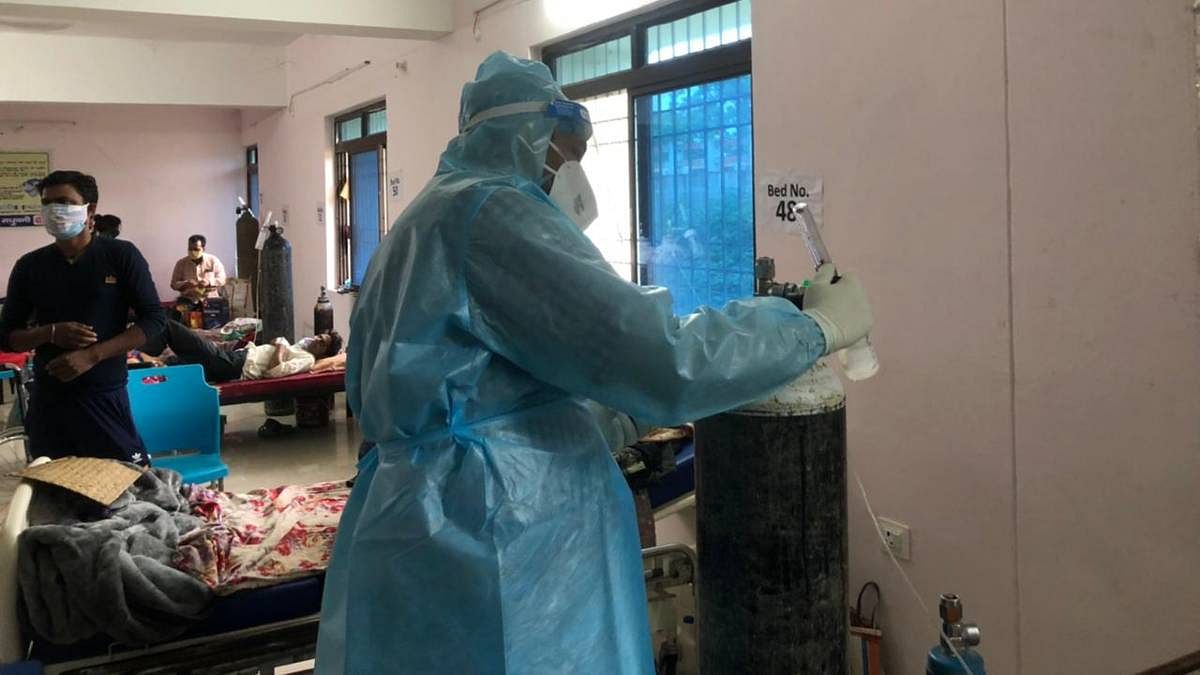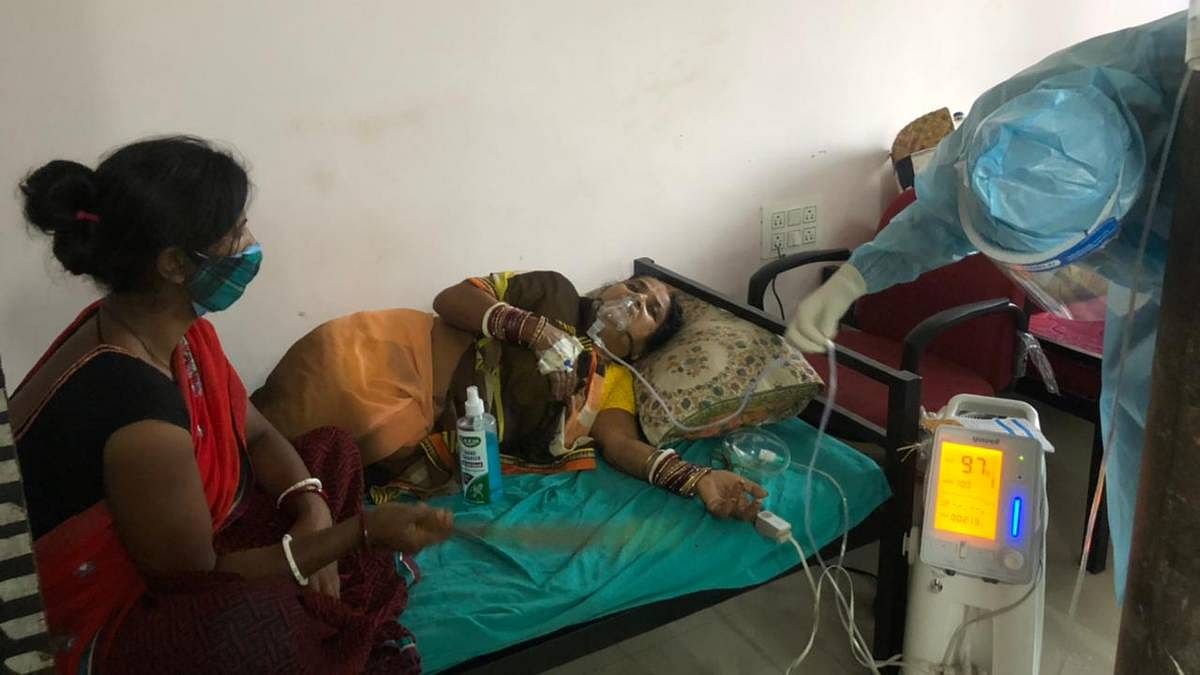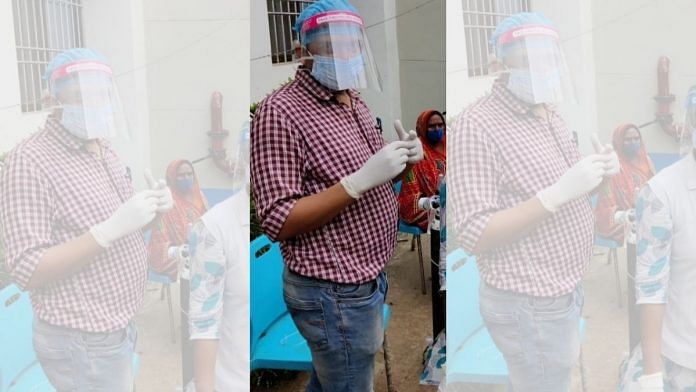Madhubani: “Sister, ghabrana nahin hai, double vaccinated hain to kuch to bachav hai (Sister, don’t worry. We have received both vaccine doses. So there’s bound to be some protection),” 37-year-old Dr Pankaj Kumar, one of the 25 doctors posted at Madhubani’s Covid Care hospital, assured an accompanying nurse as they entered the Covid ward.
Just a minute ago, the nurse, Rachna, had asked Kumar if they will live to see the next year.
“What could I have possibly told her? We are not sure about our own life now. Each day we see doctors and nurses succumbing to the virus. There is an uncertainty,” Kumar told ThePrint Thursday, the 40th day of his duty at the Madhubani hospital, during the second pandemic wave.
Originally a nursing college in Rampatti, eight kilometres from the district headquarters, the facility was turned into a Covid hospital during the first wave in the country. Kumar — who has an MBBS degree from Bhagalpur, MD from Banaras Hindu University (BHU) and senior residency at Delhi AIIMS — had served at the hospital then too. On Thursday, 89 patients were admitted at the facility that had a capacity to take in 120.
“The last wave wasn’t deadly. This centre reported only one Covid death last year, but there have already been 65 deaths here in the second surge,” he said.
This has taken a toll on the mental health of the medical staff, who also worry about their own safety. According to the data provided by the Indian Medical Association, of 329 deaths among doctors in the second Covid wave, 96 were reported from Bihar. This accounts for about 29 per cent of the total Covid deaths among medical practitioners in the country.
The doctors are also worried about their families — staying away from them is difficult, since those at home are constantly in fear of the person who is risking his or her own life to treat others. But doctors must insist on strict maintenance of isolation while at home.
In hospitals such as this one, limited infrastructure and the challenge to save as many lives as possible while also battling ignorance and hesitancy among patients to seek medical aid, adds to the frustration of doctors like Kumar.
‘We observe critical patients for one day and then if we feel that despite our best efforts, the patient has little chance of survival, we start preparing the family psychologically, telling them things like ‘Har sambhav prayas kar rahe hain, Oxygen bhi de rahe hain, Dawayi bhi jari hai…(we are making all possible efforts, oxygen and medicines are being administered…),” said Kumar, adding, “And then someone from the family says ‘kuchh bhi kijiye (do whatever it takes) to save the patient. After which we are left with nothing to say.”
ThePrint spent a day with Kumar to get a first hand feel of challenges being faced by doctors in rural areas.
Also read: India’s R value drops to 0.82, lowest ever since Covid pandemic began last year
The four dreadful words
A resident of Samastipur, Kumar travels 40 kilometres everyday to reach the hospital at 10 am. Since he is also the clinical coordinator for the hospital, he also has additional administrative responsibilities, including coordinating with the district magistrate.
But what he dreads most are the moments when he has to utter those four dreadful words — “he/she is no more”.

He gives the example of a 40-year-old teacher whose family had rushed him to the hospital early one morning after he complained of breathless and his oxygen saturation was found to be critically low.
“His wife was cradling his head in her lap. She thought he was still alive. But there was this heartbreaking moment when I had to tell her that he was already clinically dead,” he said.
The patient’s Covid test results later confirmed that he had been Covid positive. His wife and 10-year-old son also tested positive. “What do we say at a moment like this? We have to also think of those who are left behind,” he added.
The other challenge that he is constantly battling is the lack of health infrastructure in rural areas. “Rural areas don’t have adequate health infrastructure even in non-Covid times,” said Kumar.
With limited resources at his disposal — including beds, medicines and oxygen supply — Kumar often finds himself in a fix as to how best to use available supplies. To ensure better management and maintain order among distressed families of patients, the district administration has deployed police security and a sub divisional officer (SDO) at the hospital.
‘The is a level 2 Covid hospital (one that has oxygen support, but not ventilators or ICU facilities). But most of the patients come here require level 3 care (ventilator support or ICU). Often, we have to refer them to the Darbhanga Medical College & Hospital (DMCH), since that’s the bigger facility that we are officially attached to. Since the DMCH is also working in its full capacity, our referred patients come back to us. Often, we are unable to save them,” said Kumar.
Added to that is an acute shortage of manpower, said the doctor, and he often doesn’t even know who’s the ward boy, as they keep changing.
“However, the nurses at the Rampatti Covid care centre are devoted, cooperative, and well able to handle the situation, as they have been deployed here from the first Covid wave,” he said.
Also read: What scientists now say on Covid origin in Wuhan lab and what they dismissed prematurely
Rural challenges
What makes the doctors’ work even more difficult in a rural area, said Kumar, is that there is hesitancy in people to seeking medical help. Hospitals are visited only when the patient turns critical.
“The urban belt reacts differently than the rural belt. There is more awareness in cities,” he said.
First, there is a tendency to play down the severity of the disease. Then, there is testing hesitancy. “They reach out to us in the last stage. Many times, they don’t even make it to the Covid ward. They die in the ambulance while on the way,” said a frustrated Kumar.
Quacks, who command quite a following in rural Bihar, do further damage, said the doctor.
“They are not letting people come to the hospitals, which is worrying,” said Kumar.
Also read: Covid cocktail drug used to treat Trump now available in India, price is Rs 59,750
Fear for families
On Thursday, as Kumar made a round of the Covid ward, ensconced in a PPE suit, and dripping sweat and rain — it had rained in Madhubani Thursday — he fixed the oxygen supply for one patient, checked another’s pulse, and pacified distressed families.
Tilla Devi, a Covid patient in her 60s, who had come to the hospital with an oxygen level of 30, complaints, “Saans nahin aa raha, babu (I can’t breathe)”. The address ‘babu’, common in Bihar and used to convey affection, warmed his heart in the midst of the bleak medical emergency at hand. Turning to her, Kumar replied in Maithili (the local language), telling her to rest and that she will be fine soon.

As he was about to walk out of the ward, a worried Summy Ahmad, aged in his twenties, ran up to him and dragged him to his father’s bed. A Covid patient, his father was worried that he had been prescribed a ‘light’ meal — something that the family interpreted to be a sign that he was not recovering.
Kumar reassured them and told the patient, “koshish karna hai, theek hona hai (you have to try and get well).”
Meanwhile, back home, Kumar’s family spent the day worrying about him, as usual.
“If we don’t see our family, we will go into depression,” said Kumar, by way of explaining why he returned home every evening, despite the risk of carrying the infection to his family. “Our families worry about us, and we about them.”
The doctor’s aged parents are quarantined in one room of the house, his two daughters, aged four and seven, are forbidden from hugging their father. Seeing them from a distance is all that comforts the doctor, as he leaves his patients for the night, each night.
(Edited by Poulomi Banerjee)



